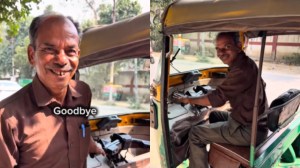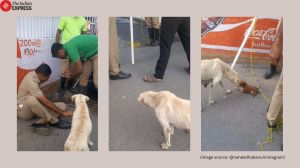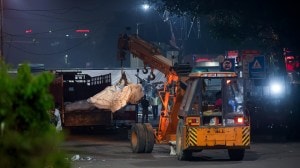Cafe everywhere
Will Starbucks in India take an elite turn,or give us a coffee shop we can call home.
Will Starbucks in India take an elite turn,or give us a coffee shop we can call home.
Starbucks Downs Shutters on 2,870 Stores,Announces Sinister Phase Two of Operations,ran the headline in the satirical newspaper,The Onion. Starbucks is quite easy to mock,as The Onion has discovered: to the standard complaint about chain-store sameness is added a murderous acquisitiveness,the desire to carpet-bomb entire neighbourhoods in its cities of operations with Starbucks stores. Hence another Onion headline: New Starbucks Opens in Rest Room of Existing Starbucks.
Yet,somehow,ubiquitous though it may be,Starbucks escapes the malice directed at so many other restaurantchains,the McDonalds and Haldirams of the world,all of which are incessantly declared soulless by-products of globalisation. That isnt surprising at all,actually. Starbucks is surprisingly hard to dislike. Perhaps its the soothing décor,all forest green and beige. Perhaps its the carefully selected music,always at just the right volume. Perhaps its the general air of good taste thats been designed and created by the Expert Committee for Good Taste in Starbucks Stores,meeting in a well-appointed room overlooking Seattles grey harbour.
It is difficult to do anything but like Starbucks,the same way it is difficult to dislike a quietly polite,politically correct and innocuous New Englander or Californian. This is no coincidence. Starbucks is representative of a particular kind of brand which emerged from the coasts or university enclaves of the United States to slowly take over a large section of merchandising and retail. Frequently founded by hippies,and now targeting hipsters,these are companies that are very,very serious about appearing laid-back. Ben and Jerrys ice cream and the Gap,like Starbucks,took a lovingly created model that stressed the local whether local ingredients or the local community ironed out the rough edges of the model and scaled it up to cater to an exploding world of disconnected city-dwellers searching for ersatz authenticity.
That connection to the local lies at the heart of what Starbucks dictatorial CEO,Harold Schultz tries to achieve. Cheerfully cannibalising the lifes work of the sociologist Ray Oldenburg,Schultz says he wants a Starbucks coffee shop to be a third place for people it serves. Not home,the first place; not work,the second,but a third where you can be in public yet relaxed,a place where you can rent belonging. A belonging that comes with its own ambience; a giant corporations attempt to connect its detached customers to the world outside.
Which,you will realise,is going to be something of a problem in middle-class India,where everyone is already pretty connected. We havent quite reached the uprooted-searching-for-a-home stage in our development as a society yet. And so our giant chains first,Barista,but now more than any other,Café Coffee Day (CCD) have quite a different feel to them,and one thats perhaps more reflective of Indian conditions. For their great contribution to our urban life has been as places to meet others outside the home,not as third-place refuge.
Thus when you walk into an orange-and-brown Barista,you hear the twang of a group playing the stores complimentary guitar instead of smooth jazz,and you dont sink into sofas the way you do at a Starbucks,you sit upright on chairs that keep conversation going. When you walk into pretty much any CCD,the wall of talk hits you: families out to placate kids with ice cream,high-schoolers meeting away from parents prying eyes,college kids on cheap dates,random people who just needed somewhere to meet away from the freezing cold or the scorching heat of the market sidewalk. (How did people ever meet each other in the days before mobiles and Baristas,anyway? I swear I cant remember,which I suspect was because I was never the one kept waiting on that sidewalk.)
Starbucks has already,perhaps,waited too long to enter India. The agreement that they announced with Tata Coffee recently combined a great deal of careful sourcing of beans from Tata estates across India,with a couple of stores thrown in almost as an afterthought. In the meantime,what we expect from a coffee shop chain seems to have become pretty much set in stone. We seem to want light,and TVs,and a bit of a crowd,and cheap coffee that we can sit over. The CCD generation,the millions across metropolitan and small-town India that have been going to their local coffee shop several times a week since they were barely teenagers,is going to be a hard market to crack. Theyre unlikely to be tempted by the careful Pacific-coast sophistication Starbucks exudes.
It is going to be a dicey battle in brand placement. What one expects will happen,of course,is what I call the Honda Inversion. A brand thats quite clearly mass-market in Western Europe or America turns up in India and takes an elitist turn. Like Hondas,or Promod,or Pizza Hut. Unsurprisingly,the first Starbucks outlets,according to reports post the Tata-Starbucks agreement,will open in Tata properties read the Taj hotels. As an upmarket,quieter,more cosmopolitan version of our locally-grown brands,Starbucks might carve out a place for itself. More so than in China,where photo after Flickr photo documents that the stores seem to have become expat hangouts almost above anything else.
And they will not be aided in this battle by the quality of their coffee. Starbucks has its thousands of stores around the world now,but do not for a moment believe that it is because their coffees the best available. Dont take a humble foodies word for it: blind tests by Consumer Reports magazine have derided their coffee as burnt and bitter,declaring that fast-food chains,even McDonalds,do it better. (That contempt need not extend to all their stuff: one particular little snack,a chocolatey peppermint brownie,deserves to be widely copied by every neighbourhood pirate bakery.)
But,after all,a coffee-shop chain isnt about coffee. It is about place. Café Coffee Days have changed our life and our society because they have provided a particular sort of place,not because people have switched to milky cappuccinos out of corporate-blazoned cups,from milky chai out of kulhars. It isnt beyond the realm of possibility that Starbucks will somehow manage a foothold of its own. After all,to those tired of the constant noise of our public spaces,of the Punjabi pop and brainless out-of-home ads that bombard you everywhere,perhaps a brown-and-green room playing Ella Fitzgerald or Paul McCartney or other greats sanctioned by the Starbucks Advisory Council On What Counts As Great Music might indeed come as a soothing relief.
For there is another service a coffee house provides,not just a space to meet. It is a space to read,a space to be outside yet unstared-at,a space to be left alone. Walk into a Starbucks anywhere in what Canadian author David Sax calls Laptopistan,and you will see a sea of quiet faces,reading,staring into their Apple PowerBooks,working,reading,beginning little enterprises or finishing little assignments in a haven thats half college canteen and half computer lab. An active,online entrepreneurial society needs not just start-up capital,but start-up quiet. JK Rowling didnt write Harry Potter at a Starbucks,but at one of the independent coffee shops in Edinburgh the chain apes and then eats; the sort that puts up on the wall covers of the books that were written there. Have you ever noticed that there isnt a quiet place to sit in this entire country? If Starbucks is on its way in,perhaps thats on its way out.
mihir.sharmaexpressindia.com



- 01
- 02
- 03
- 04
- 05




























